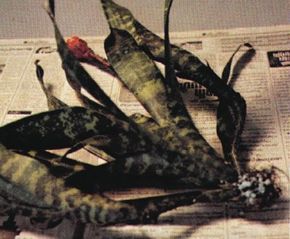Potting Bromeliads
Choosing the correct size pot and soil type is important for most plants, but this is not the case for bromeliads. In fact, bromeliads don't even need to be potted to thrive.
This section will inform you of the various potting options available to bromeliad plants.
Advertisement
Many bromeliads do not have much of a root system and do not need large pots. A full-sized Aechmea fasciata could probably grow very nicely in a four inch pot, but the pot would be much too small to hold the plant upright.
You will have to choose a larger pot -- perhaps a six inch one -- so you will not have to stand the plant up all the time. If you overpot, the roots may rot.
When potting, keep the bottom leaves level with the top of the potting medium. Pack the potting medium firmly around the plant to give it support.
Bromeliads will grow in almost any type of container as long as it has good drainage. Bromeliads are ideal no-pot candidates.
Many of them will grow very nicely affixed to chunks of fiber attached to tree branches. Small plants can even be glued directly on to pieces of driftwood.
Since bromeliads don't have much of a root system, they are usually grown as single plants. Repotting is not often necessary. When it is, be sure to choose the proper sized container.
Terrestrial bromeliads, those that grow in the ground, will grow in any commercial potting or soil mix as long as the drainage is good.
The epiphytic bromeliads, those that grow in trees, will grow in anything that has good aeration and drains well but still holds enough moisture to keep the exposed roots happy.
Materials for potting epiphytic bromeliads include osmunda fiber, fir bark, and coconut shells.
Actively growing plants can benefit occasionally from a fertilizer treatment, and bromeliads are no exception. In the next section, learn about fertilizing requirements of bromeliad plants.
